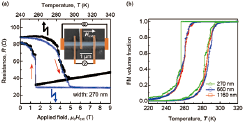Magneto-Thermodynamic Properties in Submicron Wires of Pd-doped FeRh
Otani Group
An FeRh alloy with B2 order shows a first-order phase transition from antiferromagnetic (AFM) to ferromagnetic (FM) phases with raising temperature. As the transition temperature is tunable around room temperature, this is a candidate material for several applications such as heat-assisted magnetic recording, AFM memories and memristor devices. Recently, an asymmetric behavior around the AFM-FM phase transition has been reported on some tiny sample structures. Remarkably, a discontinuous and asymmetric resistance change around the phase transition was reported in submicron wires of FeRh, which is caused by suppression of the nucleation of AFM domains during the cooling process [1]. In this work, we performed resistivity measurements of submicron wires of Pd-doped FeRh as a function of temperature and external magnetic field. We further evaluated some thermal properties such as an energy loss around the temperature hysteresis in each wire to characterize those finite-size effect.

Fig. 1. Hysteresis loops due to AFM-FM transition on submicron wires of Pd-doped FeRh [2]. (a) Resistance measurements on 270-nm-wide wire of Pd-doped FeRh against temperature (black) and in-plane magnetic field (blue). The temperature-driven hysteresis loop was measured without applying a magnetic field and the field-driven one was done at a constant temperature of 240.0 K. Inset is a SEM image of the wire. (b) Volume fraction of ferromagnetic phase against temperature which were estimated from resistance of the submicron wires.
We used Pd-doped FeRh alloy in order to decrease the AFM-FM phase transition temperature. A 60-nm-thick epitaxial film of Pd-doped FeRh was prepared and fabricated into submicron wires. Detailed processes for film growth and patterning are shown in Ref. 2. As the resistivity in AFM phase is larger than that in FM phase, the electrical transport measurement can be a probe to detect the AFM-FM phase transition which is induced by sweeping temperature or external magnetic field. The resistance on 270-nm-wide wire against temperature and magnetic field is plotted in Fig. 1(a). We can see the temperature-driven and field-driven hysteresis loops due to the AFM-FM phase transition. Though the resistance contains small jumps under the transition to FM phase, it showed a large discontinuous change on the opposite arm, the transition to AFM phase. These asymmetries and step-like structures in both hysteresis loops would indicate the nucleation processes of AFM and FM domains are confined by the sample size, which is also reported in Ref. 1. We further investigated how the hysteric behavior changes by the size of wires. We prepared 270nm-, 660-nm- and 1160-nm-wide wires by the same method and measured their resistances with sweeping temperature. Under an assumption that all magnetic domains are aligned along the longitudinal direction of the wire, the volume fraction of FM domains can be calculated from the measured resistance in each wire as shown in Fig. 1(b). We can find the enhanced asymmetry in narrow wires. To evaluate this finite-size effect in wires, we estimated the energy loss around the phase transition from simple thermodynamic equations. We found the energy losses around the hysteresis loops are larger in narrower wires. Also, all wires showed larger losses than the unpatterned film. These results would suggest that the finite-size effect, probably a restriction in magnetic domain structures across the phase transition, appears in a macroscopic energy loss. This method can be a probe to characterize the rectified domain nucleation process in tiny volume samples by simple electrical measurements.
References
- [1] V. Uhlír et al., Nature Commun. 7, 013113 (2016).
- [2] K. Matsumoto et al., IEEE Trans. Magn. 54, 2300904 (2018).
